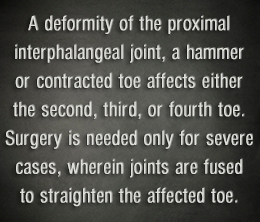Surgery for hammertoe treatment is performed only when other conventional methods fail to show positive results. The surgery involves straightening the deformed toe by correcting the tendons or fusing joints. Read on...

A hammertoe, also spelled as hammer toe, is an orthopedic deformity of any of the second, third, or fourth toes. The affected toe bends at the middle joint, resembling a clawlike arch or hammer, hence the term hammertoe is given. The main cause of hammertoe is wearing ill-fitting footwear for an extended period, causing the muscles to shorten. It may also be developed due to tendon imbalance. In either case, an individual with hammertoe usually have callus or corn covering the middle joint and the toe tip.
The notable symptoms of hammertoe problem are toe cramps, pain, and discomfort, particularly during walking and after wearing shoes. If addressed in the early stages, hammertoe can be treated effectively with splinting or toe exercising along with wearing of corn pads and comfortable shoes. Nevertheless, a delayed treatment may require tedious therapeutic procedure like surgery. In general, conservative treatment methods are tried first, failure of which may need surgery as the last treatment option.
Hammertoe Surgery Info
Prior to surgery, the doctor will take an X-ray imaging test of the affected part. From the result, the doctor will identify the degree of toe deformity. And the main objective behind conducting a surgical procedure is to correct or straighten the deformed joint. It usually involves fusing the toe joints together, cutting the bone, or rearranging the tendons of the top and bottom of the affected toe. Accordingly, the cost of hammertoe operation varies from one procedure to another. Refer to the following points for better understanding about hammertoe surgery, before and after the procedure.
Surgery Procedure
The type of toe surgery depends upon the severity of the problem (flexible or rigid) as well as the foot structure of the patient. For mild and flexible hammertoe, tendon release surgery is conducted to correct the bent toe. In this method, the tendons of the top and bottom which hold the joints are cut first, and the affected joint is straightened out to restore the normal joint shape.
Another surgery type is called arthroplasty or phalangeal head resection, wherein a part of the bone is removed from the rigid toe followed by toe straightening. The surgeon then cuts and rearranges the tendons to secure the toe. During the recovery time, tapes or wires are used to wrap the operated toe. For hammertoe cases associated with nerve damage and muscle disorders, a joint fusion procedure is performed. This approach is effective to avoid recurrent incidences of hammertoe. Under this fusion technique, the surgeon excises a small section of bone from the joint to correct the toe shape, after which a wire is placed to hold the joint. During the recovery time, the wire is removed and the joints are left to fuse permanently.
Surgery Recovery
During the surgery recovery period, the candidate is advised to take rest and stay off the feet as much as possible. Otherwise, increased pressure over the operated toe will strain the joints and muscles, causing more pain. A good solution is to use crutches while standing and walking. The doctor may also recommend wearing postoperative shoes with stiff soles for 2 - 3 weeks, or until the painful symptoms subside completely.
Surgery Complications
As with any operation procedure, this toe surgery is associated with certain complications. Immediately after the surgery, pain and swelling over the incision site are commonly manifested, which reduce gradually with time. Keeping leg in an elevated position (above a pillow) while lying down will help reduce swelling and inflammation. Other rare complications of surgery are infections, blood clotting, and chronic pain (because of nerve damage).
On the safety note, getting the toe surgery done by an experienced doctor is imperative to avoid complications and quicken the recovery time. Within 6 - 8 weeks after orthopedic treatment surgery, the patient can resume wearing his/her regular footwear. But, avoid putting tight shoes and high heel shoes until complete recovery is achieved, which may take somewhere around three months. Strictly follow the doctor's instructions to ensure a fast recovery without major complications.


 A hammertoe, also spelled as hammer toe, is an orthopedic deformity of any of the second, third, or fourth toes. The affected toe bends at the middle joint, resembling a clawlike arch or hammer, hence the term hammertoe is given. The main cause of hammertoe is wearing ill-fitting footwear for an extended period, causing the muscles to shorten. It may also be developed due to tendon imbalance. In either case, an individual with hammertoe usually have callus or corn covering the middle joint and the toe tip.
A hammertoe, also spelled as hammer toe, is an orthopedic deformity of any of the second, third, or fourth toes. The affected toe bends at the middle joint, resembling a clawlike arch or hammer, hence the term hammertoe is given. The main cause of hammertoe is wearing ill-fitting footwear for an extended period, causing the muscles to shorten. It may also be developed due to tendon imbalance. In either case, an individual with hammertoe usually have callus or corn covering the middle joint and the toe tip.